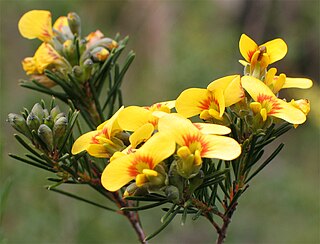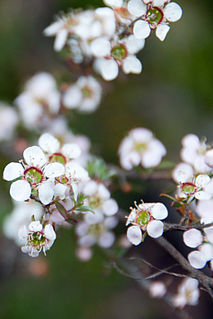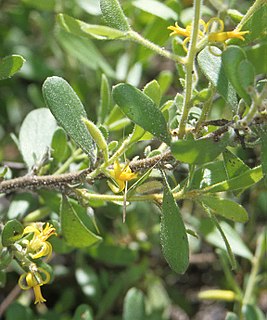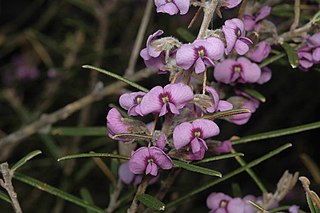
Dillwynia is a genus of about 20 species of flowering plants in the family Fabaceae, and is endemic to Australia. Plants in this genus are shrubs with simple leaves and yellow or red and yellow flowers similar to others in the family.

Dillwynia cinerascens, commonly known as grey parrot-pea, is a species of flowering plant in the family Fabaceae and is endemic to south-eastern Australia. It is an erect to low-lying shrub with linear or thread-like leaves and orange or yellow flowers.

Conospermum taxifolium, commonly known as variable smoke-bush, yew-leaf smoke bush or paint brush, is a plant in the family Proteaceae and is endemic to eastern Australia. It is an erect shrub with narrow elliptic to narrow egg-shaped leaves with the narrower end towards the base and panicles of cream-coloured to white, tube-shaped flowers.

Persoonia cornifolia is a plant in the family Proteaceae and is endemic to eastern Australia. It is a shrub with elliptic to egg-shaped leaves and hairy yellow flowers, and grows in northern New South Wales and south-eastern Queensland.

Leptospermum trinervium, commonly known as flaky-barked tea-tree, slender tea-tree or paperbark tree, is a species of shrub or small tree that is endemic to eastern Australia. It has papery bark that is shed in thin, flaking layers, narrow elliptic to broadly egg-shaped leaves with the narrower at the base, white flowers and silky-hairy fruit that falls from the plant when mature.

Leptospermum myrsinoides, commonly known as the heath tea-tree or silky tea-tree, is a species of shrub that is endemic to south-eastern continental Australia. It has smooth bark on the younger stems, narrow egg-shaped leaves with the narrower end towards the base, white flowers and fruit that has the remains of the sepals attached but usually falls from the plant soon after the seeds are released.

Persoonia sericea, commonly known as the silky geebung, is a plant in the family Proteaceae and is endemic to eastern Australia. It is a shrub with hairy yellow flowers and silky-hairy young branches and leaves.

Boronia anemonifolia, commonly known as narrow-leaved boronia or sticky boronia, is a flowering plant that is endemic to south-eastern Australia. It is a shrub with mostly pinnate leaves, with white to pale pink four-petalled flowers in leaf axils.

Hakea leucoptera, commonly known as silver needlewood, needle hakea, pin bush or water tree and as booldoobah in Koori language, is a shrub or small tree with rigid, cylindrical, sharply pointed leaves and white, cream-coloured or yellow flowers in late spring and early summer. It is widespread and common in central parts of the Australian mainland.

Prostanthera incana, commonly known as velvet mint-bush, is a species of flowering plant in the family Lamiaceae and is endemic to south-eastern continental Australia. It is an erect, moderately dense shrub with egg-shaped leaves, and lilac-coloured flowers, found mostly in near-coastal southern New South Wales.

Persoonia microphylla is a plant in the family Proteaceae and is endemic to New South Wales. It is an erect to prostrate shrub with elliptic to egg-shaped leaves and yellow flowers in groups of up to fourteen on a rachis up to 30 mm (1.2 in) long.

Epacris calvertiana is a plant of the heath family, Ericaceae and is endemic to New South Wales. It is an erect to diffuse shrub with elliptic to egg-shaped leaves with a sharp-pointed tip and with white, pink or red flowers arranged along the ends of leafy branchlets.

Hovea rosmarinifolia, commonly known as mountain beauty or rosemary hovea is a shrub in the family Fabaceae, native to Australia. A small shrub bearing attractive blue-purple or mauve pea flowers from August to November.

Leptospermum multicaule, commonly known as the silver tea-tree, is a species of shrub that is endemic to south eastern Australia. It has linear, narrow elliptical or narrow egg-shaped leaves, white or pink flowers usually borne singly on short side shoots, and fruit the falls from the plant soon after the seeds are released.
Philotheca obovalis is a species of flowering plant in the family Rutaceae and is endemic to New South Wales. It is a small shrub with broadly egg-shaped to heart-shaped leaves with the narrower end towards the base, and white flowers tinged with pink and arranged singly in leaf axils.
Triplarina nowraensis, commonly known as Nowra myrtle heath, is a species of flowering plant in the myrtle family, Myrtaceae and is endemic to a restricted area of New South Wales. It is a shrub with egg-shaped to lance-shaped leaves with the narrower end towards the base, flowers with five sepals, five cream-coloured to white petals and fifteen to seventeen stamens.

Hibbertia crinita is a species of flowering plant in the family Dilleniaceae and is endemic to south-eastern continental Australia. It is a spreading to low-lying shrub with hairy foliage, linear to lance-shaped or elliptic leaves and yellow flowers with ten to fifteen stamens arranged on one side of two carpels.

Dillwynia acerosa is a species of flowering plant in the family Fabaceae and is endemic to Western Australia. It is an erect spindly shrub with hairy, needle-shaped leaves and yellow flowers.

Dillwynia brunioides, commonly known as sandstone parrot-pea, is a species of flowering plant in the family Fabaceae and is endemic to New South Wales. It is an erect shrub with silky-hairy stems, linear, grooved leaves and yellow flowers with red markings.
Dillwynia crispii is a species of flowering plant in the family Fabaceae and is endemic to Morton National Park in eastern New South Wales. It is an erect shrub with glabrous, linear leaves and yellow flowers with red markings.

















